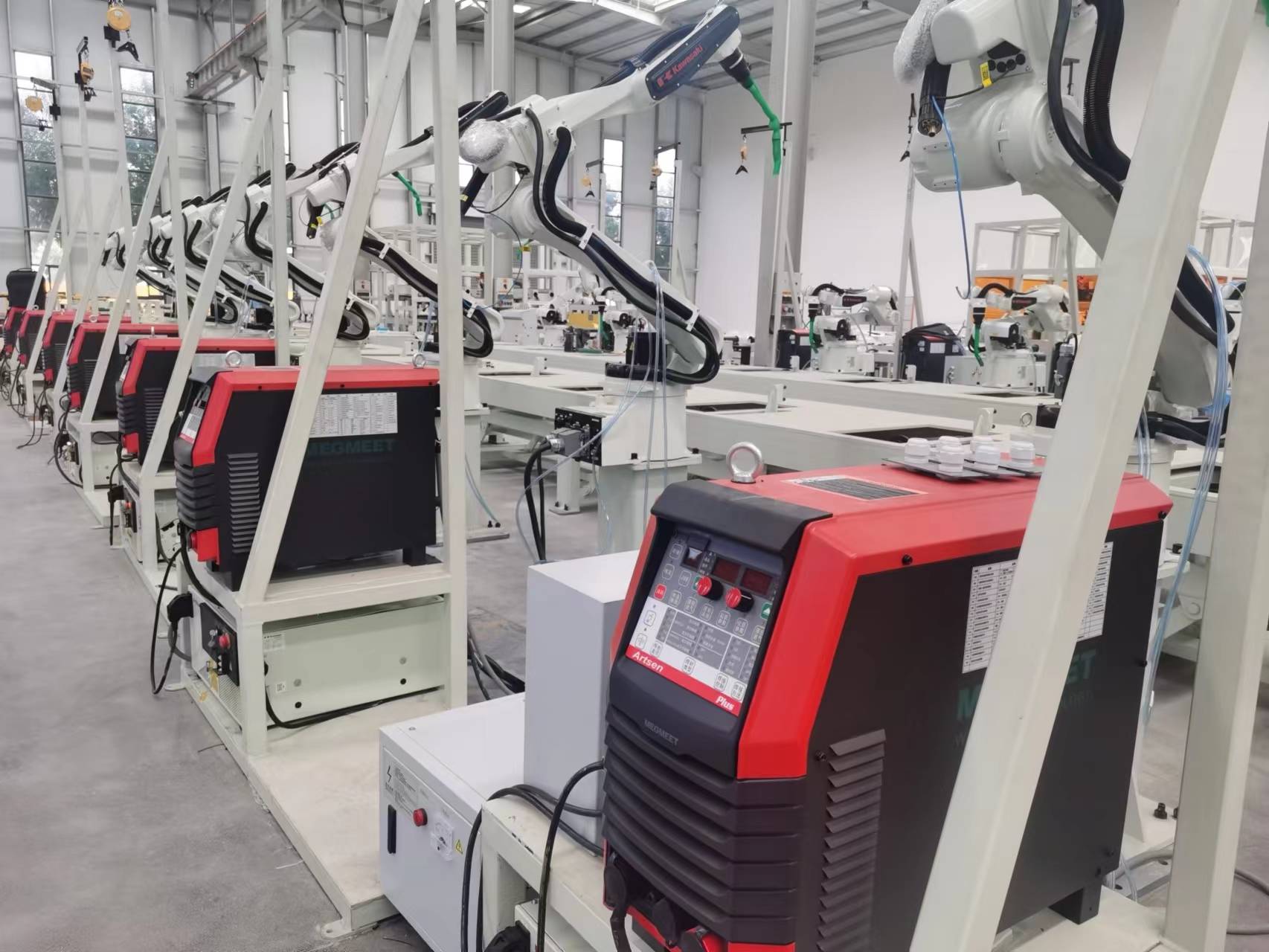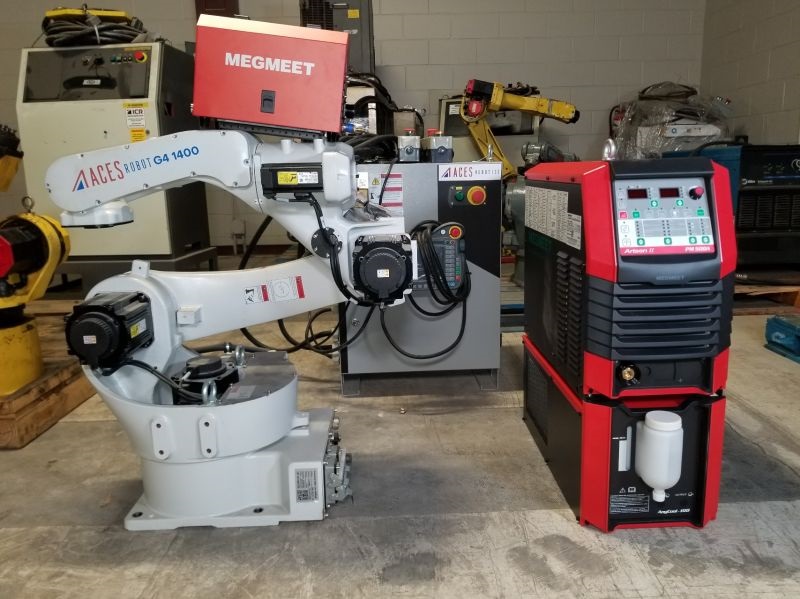In the ever-evolving landscape of manufacturing, advancements in technology have played a pivotal role in enhancing efficiency, precision, and productivity. Robotic welding stands out as a prime example of this technological evolution, offering manufacturers a powerful tool to streamline their welding processes. This article delves into the world of robotic welding, addressing fundamental questions such as what it is, how it works, its types, a comparison with manual welding, advantages for manufacturers, applications, and a glimpse into the future of this transformative technology.

I. What is Robotic Welding?
1) Definition and Overview
Robotic welding is a form of automation in which industrial robots perform welding tasks with minimal human intervention. These robots are equipped with welding equipment, enabling them to join materials together through the application of heat and pressure. This automated process is designed to enhance efficiency, consistency, and precision in welding applications.
2) Evolution of Robotic Welding
The roots of robotic welding can be traced back to the mid-20th century when the first industrial robots were introduced. However, it wasn't until the late 20th century that robotic welding gained widespread acceptance in manufacturing. Early systems were limited in terms of capabilities and sophistication, but continuous technological advancements have transformed robotic welding into a highly reliable and efficient method.
II. How Does Robotic Welding Work?
1) Components of a Robotic Welding System
A typical robotic welding system consists of several key components:
Robotic Arm: The heart of the system, the robotic arm is responsible for carrying out welding tasks. It is programmable and can move with a high degree of precision.
Controller: This is the brain of the system, where the programming and coordination of the robotic arm take place. Modern controllers are equipped with advanced software that enables intricate control and monitoring of the welding process.
Welding Equipment: The robotic arm is fitted with welding tools, such as welding torches or electrodes, depending on the welding process.
Sensors: Sensors are integrated into the system to provide real-time feedback on the welding process. This helps in maintaining accuracy and adjusting parameters as needed.

2) Programming and Operation
Robotic welding systems are programmed using specialized software that allows operators to define the welding path, parameters, and other variables. The programming can be done offline, reducing downtime on the production floor. Once programmed, the robotic system operates autonomously, executing precise and repetitive welding tasks with minimal human involvement.
III. Common Types of Robotic Welding Processes
1. Arc Welding:
Gas Metal Arc Welding (GMAW): Also known as MIG (Metal Inert Gas) welding, it uses a wire electrode and a shielding gas to create the weld.
Gas Tungsten Arc Welding (GTAW): Commonly known as TIG (Tungsten Inert Gas) welding, it uses a tungsten electrode and a shielding gas, often without a filler material.

2. Spot Welding:
Resistance Spot Welding (RSW): Involves passing an electric current through metal sheets to create localized welds at predetermined spots.
3. Laser Welding:
Laser Beam Welding (LBW): Utilizes a laser beam to melt and join metals, offering high precision and minimal heat-affected zones.
4. Friction Welding:
Linear Friction Welding (LFW): Involves rubbing two materials together under pressure to create a weld without melting.
These processes cater to a wide range of materials and applications, providing manufacturers with flexibility and adaptability in their welding operations.
IV. Robotic Welding vs. Manual Welding: Which is Better?
1) Precision and Consistency
Robotic welding excels in precision and consistency. Once programmed, a robotic system can replicate the same weld with remarkable accuracy, reducing variations in the final product. Manual welding, on the other hand, relies on the skill and experience of the welder, leading to potential inconsistencies.
2) Efficiency and Speed
Robotic welding is inherently faster and more efficient than manual welding. Robots can work continuously without breaks, leading to increased production rates and reduced cycle times. Manual welding, while offering a human touch, is limited by factors such as fatigue and the need for breaks.
3) Complex and Repetitive Tasks
Robotic welding shines in scenarios involving complex and repetitive tasks. It can handle intricate welding patterns and consistently deliver high-quality results. Manual welding may struggle with such tasks, especially over extended periods.
4) Adaptability
Manual welding is often more adaptable to unique or irregular workpieces. Skilled welders can adjust their techniques based on the specific requirements of a project. Robotic welding, while versatile, may face challenges in adapting to highly variable tasks.
5) Cost Considerations
While the initial setup cost of robotic welding systems can be high, the long-term cost benefits often outweigh manual welding. The increased speed, efficiency, and consistency contribute to reduced labor costs and improved overall productivity.
In conclusion, the choice between robotic and manual welding depends on the specific needs of a manufacturing operation. While robotic welding excels in consistency and efficiency, manual welding offers adaptability and a human touch that may be essential in certain applications.
Robotic welding excels in precision and consistency. Once programmed, a robotic system can replicate the same weld with remarkable accuracy, reducing variations in the final product. Manual welding, on the other hand, relies on the skill and experience of the welder, leading to potential inconsistencies.
V. Key Advantages of Robotic Welding for Manufacturers
1. Increased Productivity
Robotic welding systems operate continuously, leading to higher productivity and reduced production times. This efficiency is particularly beneficial for high-volume manufacturing where consistency and speed are paramount.
2. Improved Precision and Consistency
The programmed nature of robotic welding ensures that each weld is executed with precision and consistency. This results in higher-quality products and reduces the likelihood of defects or variations in the final output.
3. Enhanced Safety
By automating the welding process, manufacturers can significantly improve workplace safety. Robots can handle hazardous tasks without putting human operators at risk, such as working in confined spaces or dealing with toxic fumes.
4. Cost Savings
While the initial investment in robotic welding systems can be substantial, the long-term cost savings are significant. Reduced labor costs, increased efficiency, and minimized material waste contribute to a positive return on investment over time.
5. 24/7 Operation
Unlike human operators who require breaks and rest, robotic welding systems can operate 24/7. This non-stop production capability maximizes the utilization of resources and ensures continuous output.
6. Consistent Quality
Robotic welding eliminates the variability associated with manual welding, ensuring consistent weld quality. This is crucial in industries where product integrity and adherence to strict quality standards are paramount.
7. Scalability
Robotic welding systems can be easily scaled to meet changing production demands. Whether the need is for increased output or a shift in product specifications, the flexibility of robotic systems accommodates such changes seamlessly.
These advantages position robotic welding as a transformative technology for manufacturers seeking to optimize their welding processes and stay competitive in today's fast-paced industrial landscape.
VI. Applications of Robotic Welding
1. Automotive Manufacturing
The automotive industry has been a pioneer in adopting robotic welding for the assembly of vehicle components. Robotic systems excel in welding car bodies, chassis, and various structural elements with precision and speed.
2. Aerospace Industry
In the aerospace sector, where precision and quality are non-negotiable, robotic welding plays a crucial role. It is used in the fabrication of aircraft components, ensuring the structural integrity and reliability of the final products.
3. Shipbuilding
Robotic welding is extensively utilized in shipbuilding for the assembly of large and complex structures. The ability of robotic systems to handle repetitive and intricate welding tasks is well-suited to the demands of ship construction.
4. Construction
In the construction industry, robotic welding contributes to the fabrication of steel structures, bridges, and other architectural elements. The speed and precision of robotic welding enhance construction efficiency while maintaining structural integrity.
5. Industrial Equipment Manufacturing
Manufacturers of industrial machinery and equipment leverage robotic welding for the fabrication of components and structures. This application ensures high-quality welds and contributes to the overall reliability of the machinery.
6. Consumer Electronics
Robotic welding is increasingly finding applications in the production of consumer electronics, particularly for components that require precise and intricate welding. The automation of this process contributes to the efficiency of electronics manufacturing.
7. Energy Sector
In the energy sector, robotic welding is employed in the fabrication of pipelines, pressure vessels, and other components critical to energy infrastructure. The high level of precision and consistency ensures the integrity of these structures.
These diverse applications showcase the versatility of robotic welding, making it a valuable asset across various industries.
VII. The Future of Robotic Welding
1. Integration with Industry 4.0 Technologies
The future of robotic welding lies in its integration with Industry 4.0 technologies, such as the Internet of Things (IoT) and Artificial Intelligence (AI). This integration will enable robotic welding systems to communicate, analyze data in real time, and make autonomous decisions, further enhancing efficiency and adaptability.
2. Collaborative Robots (Cobots)
The development of collaborative robots, or cobots, marks a significant trend in the future of robotic welding. Cobots are designed to work alongside human operators, combining the precision of automation with the adaptability of human intervention. This collaborative approach can open new possibilities in industries where a hybrid of manual and robotic welding is desirable.
3. Advanced Materials and Processes
As manufacturing materials continue to evolve, robotic welding systems will need to adapt to handle advanced materials and novel welding processes. This includes the integration of robotics in emerging fields such as additive manufacturing and 3D printing.
4. Enhanced Sensing and Vision Systems
Future robotic welding systems are likely to feature enhanced sensing and vision systems, allowing for even greater accuracy and adaptability. These systems may enable robots to navigate complex workpieces, detect defects in real-time, and make adjustments on the fly.
5. Customization and Small-Batch Production
The future of manufacturing is trending towards increased customization and small-batch production. Robotic welding systems will need to evolve to handle the demands of flexible manufacturing, where the ability to switch rapidly between different products and specifications is essential.
6. Sustainability and Environmental Considerations
As sustainability becomes a focal point in manufacturing, future robotic welding systems may incorporate eco-friendly practices. This includes the optimization of energy usage, reduction of material waste, and adherence to environmentally conscious welding processes.
In conclusion, the future of robotic welding holds exciting prospects, driven by technological advancements that aim to make these systems more intelligent, adaptable, and sustainable.
VIII. Conclusion
Robotic welding has emerged as a transformative force in the manufacturing landscape, offering unparalleled efficiency, precision, and consistency in welding processes. From automotive assembly lines to aerospace manufacturing, the applications of robotic welding are vast and diverse. The advantages it brings, including increased productivity, cost savings, and enhanced safety, position it as a cornerstone technology for modern manufacturing.
While the comparison between robotic and manual welding continues, it is evident that each method has its strengths and limitations. The choice between them depends on the specific needs of a manufacturing operation and the desired balance between automation and human intervention.
As we look to the future, the integration of robotic welding with cutting-edge technologies and the evolution of collaborative robots promise to reshape the industry. The ongoing pursuit of advanced materials, enhanced sensing systems, and a focus on sustainability underscores the dynamic nature of robotic welding in adapting to the ever-changing demands of the manufacturing world.
In essence, robotic welding is not just a technological tool; it is a catalyst for innovation, efficiency, and progress in the realm of manufacturing. As industries continue to embrace automation, the role of robotic welding will only become more central in shaping the future of how we build, create, and fabricate.
Related articles
1. What are the Importances Of Robotic Welding Systems In Industries?
2. How to Improve Robotic Welding Performance?
3. Robotic Welding & Complete Automation Solutions
4. Robotic Welding: Definition, Types, Processes, Pros and Cons
5. Aluminum Framework of Windows and Doors Robotic Welding - Using DEX PM3000 R Welder






